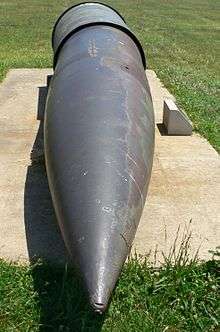Projectile
A projectile is any object thrown by the exertion of a force.[1] It can also be defined as an object launched into the space and allowed to move free under the influence of gravity and air resistance.[2]Although any object in motion through space (for example a thrown baseball, kicked football, fired bullet, thrown arrow, stone released from catapult) may be called projectiles, they are commonly found in warfare and sports.[3][4] Mathematical equations of motion are used to analyze projectile trajectories.
Motive force

Blowguns and pneumatic rifles use compressed gases, while most other guns and cannons utilize expanding gases liberated by sudden chemical reactions by propellants like smokeless powder. Light-gas guns use a combination of these mechanisms.
Railguns utilize electromagnetic fields to provide a constant acceleration along the entire length of the device, greatly increasing the muzzle velocity.
Some projectiles provide propulsion during flight by means of a rocket engine or jet engine. In military terminology, a rocket is unguided, while a missile is guided. Note the two meanings of "rocket" (weapon and engine): an ICBM is a guided missile with a rocket engine.
An explosion, whether or not by a weapon, causes the debris to act as multiple high velocity projectiles. An explosive weapon, or device may also be designed to produce many high velocity projectiles by the break-up of its casing, these are correctly termed fragments.
Delivery projectiles
Many projectiles, e.g. shells, may carry an explosive charge or another chemical or biological substance. Aside from explosive payload, a projectile can be designed to cause special damage, e.g. fire (see also early thermal weapons), or poisoning (see also arrow poison).
Sport projectiles
In projectile motion the most important force applied to the ‘projectile’ is the propelling force, in this case the propelling forces are the muscles that act upon the ball to make it move, and the stronger the force applied, the more propelling force, which means the projectile (the ball) will travel farther. See pitching, bowling.
Kinetic projectiles
A projectile that does not contain an explosive charge or any other kind of payload is termed a kinetic projectile, kinetic energy weapon, kinetic energy warhead, kinetic warhead, kinetic kill vehicle or kinetic penetrator. Typical kinetic energy weapons are blunt projectiles such as rocks and round shots, pointed ones such as arrows, and somewhat pointed ones such as bullets. Among projectiles that do not contain explosives are those launched from railguns, coilguns, and mass drivers, as well as kinetic energy penetrators. All of these weapons work by attaining a high muzzle velocity, or initial velocity, generally up to (hypervelocity), and collide with their targets, converting their kinetic energy into destructive shock waves and heat. Other types of kinetic weapons are accelerated over time by a rocket engine, or by gravity. In either case, it is the kinetic energy of the projectile that destroys its target.
Some kinetic weapons for targeting objects in spaceflight are anti-satellite weapons and anti-ballistic missiles. Since in order to reach an object in orbit it is necessary to attain an extremely high velocity, their released kinetic energy alone is enough to destroy their target; explosives are not necessary. For example: the energy of TNT is 4.6 MJ/kg, and the energy of a kinetic kill vehicle with a closing speed of 10 km/s (22,000 mph) is 50 MJ/kg. This saves costly weight and there is no detonation to be precisely timed. This method, however, requires direct contact with the target, which requires a more accurate trajectory. Some hit-to-kill warheads are additionally equipped with an explosive directional warhead to enhance the kill probability (e.g. Israeli Arrow missile or U.S. Patriot PAC-3).
With regard to anti-missile weapons, the Arrow missile and MIM-104 Patriot PAC-2 have explosives, while the Kinetic Energy Interceptor (KEI), Lightweight Exo-Atmospheric Projectile (LEAP, used in Aegis BMDS), and THAAD do not (see Missile Defense Agency).
A kinetic projectile can also be dropped from aircraft. This is applied by replacing the explosives of a regular bomb with a non-explosive material (e.g. concrete), for a precision hit with less collateral damage. A typical bomb has a mass of 900 kg (2,000 lb) and a speed of impact of 800 km/h (500 mph). It is also applied for training the act of dropping a bomb with explosives. This method has been used in Operation Iraqi Freedom and the subsequent military operations in Iraq by mating concrete-filled training bombs with JDAM GPS guidance kits, to attack vehicles and other relatively "soft" targets located too close to civilian structures for the use of conventional high explosive bombs.
A Prompt Global Strike may use a kinetic weapon. A kinetic bombardment may involve a projectile dropped from Earth orbit.
A hypothetical kinetic weapon that travels at a significant fraction of the speed of light, usually found in science fiction, is termed a relativistic kill vehicle (RKV).
Wired projectiles
Some projectiles stay connected by a cable to the launch equipment after launching it:
- for guidance: wire-guided missile (range up to 4,000 metres or 13,000 feet)
- to administer an electric shock, as in the case of a Taser (range up to 10.6 metres or 35 feet); two projectiles are shot simultaneously, each with a cable.
- to make a connection with the target, either to tow it towards the launcher, as with a whaling harpoon, or to draw the launcher to the target, as a grappling hook does.
- Bolo shotgun ammunition
Typical projectile speeds
| Projectile | Speed | Specific kinetic energy (J/kg) | |||
|---|---|---|---|---|---|
| (m/s) | (km/h) | (ft/s) | (mph) | ||
| Object falling 1 m (in vacuum, at Earth's surface) | 4.43 | 15.948 | 14.5 | 9.9 | 9.8 |
| Object falling 10 m (in vacuum, at Earth's surface) | 14 | 50.4 | 46 | 31 | 98 |
| Thrown club (expert thrower) | 40 | 144 | 130 | 90 | 800 |
| Object falling 100 m (in vacuum, at Earth's surface) | 45 | 162 | 150 | 100 | 980 |
| Refined (flexible) atlatl dart (expert thrower) | 45 | 162 | 150 | 100 | 1,000 |
| Ice hockey puck (slapshot, professional player) | 50 | 180 | 165 | 110 | 1,300 |
| 80-lb-draw pistol crossbow bolt | 58 | 208.8 | 190 | 130 | 1,700 |
| War arrow shot from a 150 lbs medieval warbow | 63 | 228.2 | 208 | 141 | 2,000 |
| Blunt Impact Projectile shot from a 40mm grenade launcher | 87 | 313.2 | 285 | 194.6 | 3,785 |
| Paintball fired from marker | 91 | 327.6 | 300 | 204 | 4,100 |
| 175-lb-draw crossbow bolt | 97 | 349.2 | 320 | 217 | 4,700 |
| 6 mm Airsoft pellet | 100 | 360 | 328 | 224 | 5,000 |
| Air Rifle BB 4.5 mm | 150 | 540 | 492 | 336 | 11,000 |
| Air gun pellet .177" (magnum-power air rifle) | 305 | 878.4 | 1,000 | 545 | 29,800 |
| 9×19mm (bullet of a pistol) | 340 | 1224 | 1,116 | 761 | 58,000 |
| 12.7×99 mm (bullet of a heavy machine gun) | 800 | 2,880 | 2,625 | 1,790 | 320,000 |
| German Tiger I 88 mm (tank shell- Pzgr. 39 APCBCHE) | 810 | 2,899 | 2,657 | 1,812 | 328,050 |
| 5.56×45mm (standard round used in many modern rifles) | 920 | 3,312 | 3,018 | 2,058 | 470,000 |
| 20×102mm (standard US cannon round used in fighter cannons) | 1,039 | 3,741 | 3,410 | 2,325 | 540,000 |
| 25×1400mm (APFSDS, tank penetrator) | 1,700 | 6,120 | 5,577 | 3,803 | 1,400,000 |
| 2 kg tungsten Slug (from Experimental Railgun) | 3,000 | 10,800 | 9,843 | 6,711 | 4,500,000 |
| MRBM reentry vehicle | Up to 4,000 | Up to 14,000 | Up to 13,000 | Up to 9,000 | Up to 8,000,000 |
| projectile of a light-gas gun | Up to 7,000 | Up to 25,000 | Up to 23,000 | Up to 16,000 | Up to 24,000,000 |
| Satellite in low earth orbit | 8,000 | 29,000 | 26,000 | 19,000 | 32,000,000 |
| Exoatmospheric Kill Vehicle | ~10,000 | ~36,000 | ~33,000 | ~22,000 | ~50,000,000 |
| Projectile (e.g., space debris) and target both in low earth orbit | 0–16,000 | ~58,000 | ~53,000 | ~36,000 | ~130,000,000 |
| 7 TeV particle in LHC[6] | 299,792,455 [note 1] | 1,079,252,839 | 983571079 | 670,616,536 | ~6.7 × 1020 [note 2] |
Equations of motion
An object projected at an angle to the horizontal has both the vertical and horizontal components of velocity. The vertical component of the velocity on the y-axis is given as while the horizontal component of the velocity is . There are various calculations for projectiles at a specific angle :
1. Time to reach maximum height. It is symbolized as (), which is the time taken for the projectile to reach the maximum height from the plane of projection. Mathematically, it is given as where = acceleration due to gravity (app 9.81m/s²), = initial velocity (m/s) and = angle made by the projectile with the horizontal axis.
2. Time of flight (): this is the total time taken for the projectile to fall back to the same plane from which it was projected. Mathematically it is given as .
3. Maximum Height (): this is the maximum height attained by the projectile OR the maximum displacement on the vertical axis (y-axis) covered by the projectile. It is given as .
4. Range (): The Range of a projectile is the horizontal distance covered (on the x-axis) by the projectile. Mathematically, . The Range is maximum when angle = 45°, i.e. .
See also
- Atlatl
- Ballistics
- Gunpowder
- Bullet
- Impact depth
- Kinetic bombardment
- Shell (projectile)
- Projectile point
- Projectile use by animals
- Arrow
- Dart
- Missile
- Sling ammunition
- Spear
- Torpedo
- Range of a projectile
- Space debris
- Trajectory of a projectile
References
- "Definition of PROJECTILE". Retrieved 13 April 2017.
- Pius, Okeke; Maduka, Anyakoha (2001). Senior Secondary School Physics. Macmillan,Lagos, Nigeria.
- "The free Dictionary". Retrieved 2010-05-19.
- "Dictionary.com". Retrieved 2010-05-19.
- Pepin, Matt (2010-08-26). "Aroldis Chapman hits 105 mph". Boston.com. Archived from the original on 31 August 2010. Retrieved 2010-08-30.
- "Facts and figures". European Organization for Nuclear Research. CERN. 2008. Archived from the original on 2018-07-02. Retrieved 2018-07-02.
- Heidi Knecht (29 June 2013). Projectile Technology. Springer Science & Business Media. ISBN 978-1-4899-1851-2.
External links
| Wikimedia Commons has media related to Projectiles. |
| Look up projectile in Wiktionary, the free dictionary. |
